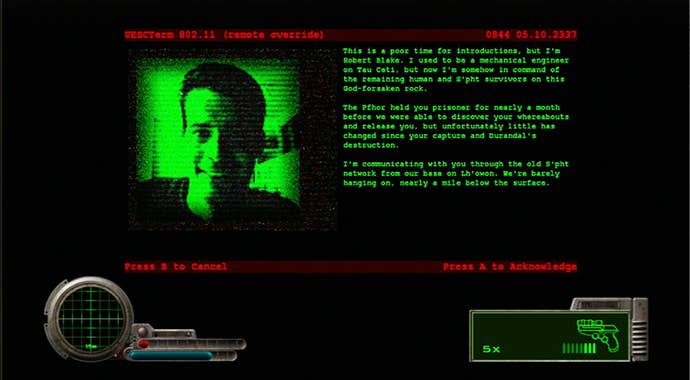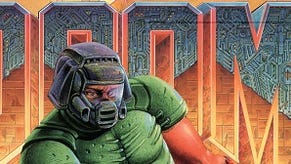Daily Classic: Marathon, The Other Thinking Man's Shooter
System Shock wasn't the only early FPS to put a cyberpunk twist on run-and-gun action.
This article first appeared on USgamer, a partner publication of VG247. Some content, such as this article, has been migrated to VG247 for posterity after USgamer's closure - but it has not been edited or further vetted by the VG247 team.
They say that if you were to give an infinite number of monkeys and infinite number of typewriters, eventually they'd bang out the collected works of Shakespeare. But when it came to early first-person shooter developers, that sort of coincidence happened with much less effort.
Despite being released only a couple of months after System Shock, Bungie's Marathon turned out to be a weirdly similar take on the FPS in many respects. Both games saw players take the role of a sci-adventurer trapped on an isolated spacebound location, go up against a rogue artificial intelligence, and unlock an extensive plot indirectly through text relayed via computer terminals. The narrative and mechanical connections between the two would suggest some liberal borrowing on Bungie's behalf if not for the fact that the games came out in such rapid succession. It's just one of those things, apparently.

For Bungie, Marathon represented a variant on their previous creation, Pathways Into Darkness. Where that game had been, essentially, a graphical adventure (a la Myst or The Journeyman Project) that played out with the mechanics of an FPS, Marathon was an FPS that happened to feature elements of a graphical adventure. Its inventory system was far simpler than either Pathways in Darkness' or System Shock's, and there were no character upgrades to speak of; on the other hand, when it came to twitch shooting and manic combat, Marathon won hands down.
Marathon played a lot like Doom for the most part, but it featured more varied objectives. Admittedly, these usually amounted to "flip a switch somewhere" or "blow this thing up" or "reach the exit," but the involved narrative provided a great deal of window dressing for even the most mundane chores. Marathon went to great pains to explain why you were running around shooting things, why certain security drones would help you while others would open fire on you, what you were supposed to be doing when you were beamed over to the aliens' vessel, and what that giant cyborg in the weird throne room was all about.
Meanwhile, you as the lone space marine (technically, a security office) found yourself caught in a three-way war between a group of AIs designed to help run the day-to-day operations of the colony vessel Marathon and who all had their own ambitions. Loyal Leela tried to help from start to finish, constrained by the original parameters of her programming. Meanwhile, Durandal went rogue early and spent most of the middle game taunting you as he overrode Leela's lock on you to force you to do his bidding. And finally, Tycho appeared to have been taken offline during the alien attack that preceded the action, only to appear later on as the aliens' pet AI, whose grudge against Durandal and humanity was practically weaponized. The plot twisted and turned as you read both messages from the various AIs as well as other supplemental documents in Marathon's systems, and while you could certainly just bumble your way through the action without bothering to soak up the story, all that narrative made a great shooter even better.

Despite its talkiness, Marathon didn't slouch in the action department. It featured top-notch combat design, with dual functions for most weapons (a grenade launcher on the assault rifle, a charge shot for the plasma pistol, etc.) and a respectable array of enemy warriors to use those guns against. Level designs tended to be fairly intricate, with a number of navigational puzzles in place of Doom's annoying hidden doors. Although some of the aesthetic choices could be puzzling – this was a colony ship, so what was up with the open pools of molten magma? – the various locations you fought through each had their own unique feel. The Marathon herself was vast and intricate, while the alien vessel featured weird pulsating geometry and a decided lack of player-friendly features (recharge stations, computer terminals). And the brief excursion to a remote human colony was particularly memorable, forcing players to navigate an incredibly complex installation while racing against time and oxygen drain in the exterior vacuum of space.
And, like System Shock, Marathon ended up becoming a cult classic – though a different sort than Looking Glass' game. Bungie's project is most beloved among the tenacious types who embraced the idiocy of being Mac users during Apple's most inept era, as Marathon was one of the few top-flight action games designed exclusively for the platform at the time. At a time when Mac gamers were lucky to get half-hearted ports a year or two after a DOS release, Marathon's exclusivity was like sweet ambrosia. And clearly the game means a lot to Bungie, too, since Halo turned out to be Marathon reinvented as a cinematic action game, and Destiny appears cut from much of the same cloth as well.
Like most early shooters, Marathon is readily available for rediscovery thanks to modern rebuilds of its open-source code. Sure, it shows its age in a lot of ways... but at the same time it's kind of nice to go back and revisit the '90s, when you could get lost in an FPS like Marathon, Doom, or Descent. There's more to gaming than marching down a succession of cinematic shooting gallery hallways, after all.

